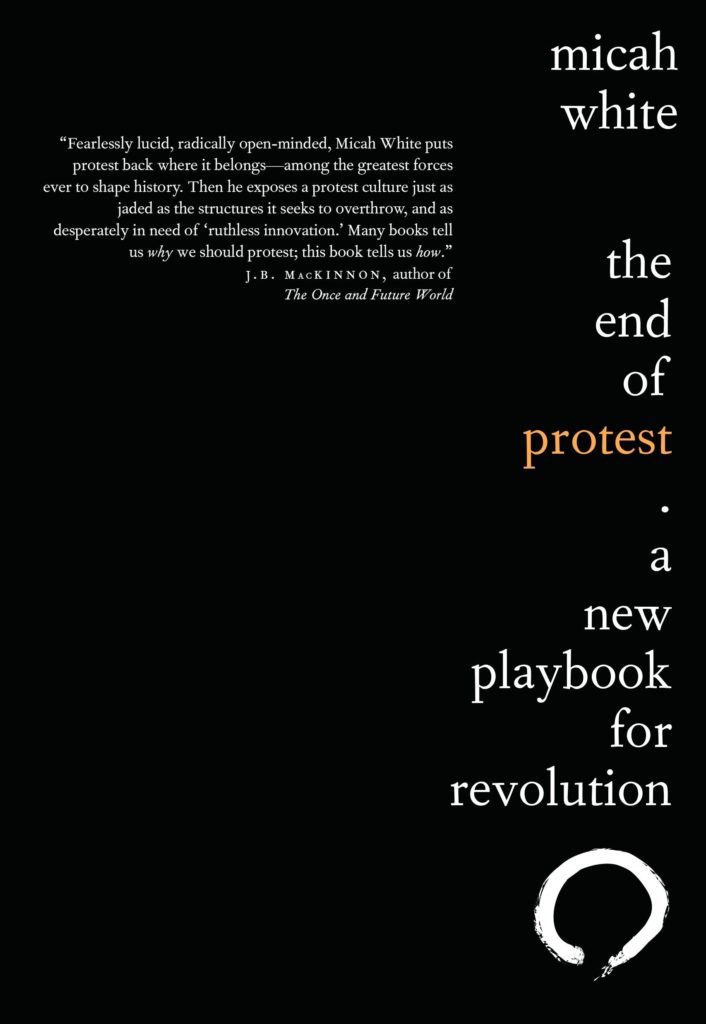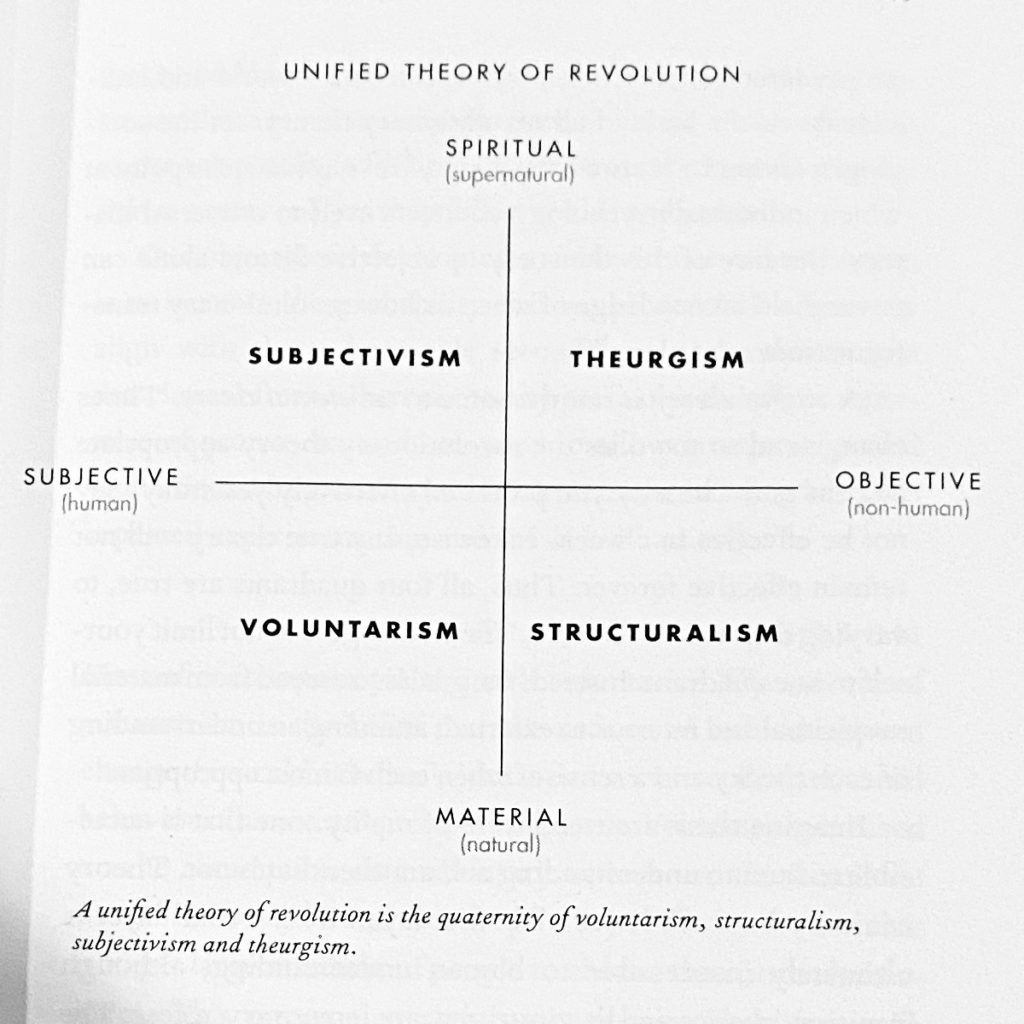
In The End of Protest: A New Playbook for Revolution, Micah White, one of the original authors of the occupy movement, lays out the future of activism, and protest won’t necessarily be a part.
“…the assumptions underlying contemporary protest are false. Change won’t happen through the old models of activism. Western democracies will not be swayed by public spectacles and mass media frenzy. Protests have become an accepted, and therefore ignored, by-product of politics-as-usual. Western governments are not susceptible to international pressure to heed the protests of their citizens.”
I’m not sure how much I agree with this theme of the book – but he makes some good points.
“The end of protest is a call to revolutionize activism.” (Nice pun!)
“The old tactics must be abandoned…The solution is innovation.”
Importance of Activism and Revolution
Wendell Phillips, American abolitionist (1848): “Revolution is the only thing, the only power that ever worked out freedom for any people.”
U.S. Supreme Court Justice Robert Houghwout Jackson (1950): We cannot ignore the fact that our own government originated in revolution, and is legitimate only if overthrow by force can somehow be justified…”
We have to remember, like St. Augustine said (5th century, C.E.) (and Martin Luther King, Jr. quoted in 1963): Lex injusta non est lex – “an unjust law is no law at all.” White adds: “There is no way to fundamentally change society without disobeying unjust laws and disturbing existing social structures.”
“Activists protest to release positive change in their life, their community, their environment.”
Revolutionary Theory
I’m going to jump to revolutionary theory, which I found fascinating.

I can’t do justice to this in a short review, but I’ll try to hit some highlights.
Revolutions can be thought of on 2 spectrums. The vertical spectrum is Spiritual/Material – this is natural versus supernatural. The horizontal spectrum is Subjective/Objective. Which is more human/non-human. You can see that revolutions will fall into four quadrants.
Voluntarism on the bottom left (the Material/Subjective quadrant) is primarily what we have now – human-led and material. It’s all about what can I do to make a change.
Structuralism, on the bottom right (Material/Objective), says that revolution has material (non-spiritual) causes, but not by humans. Weird! As White states, “Voluntarists bristle at the suggestion that action is irrelevant to success.”
But taken together, I think that I see what he’s trying to say. For example, the BLM movement started in 2013 – but maybe it’s the circumstances in 2020 that are making it that much more powerful.
And structuralism has some interesting points! “…if choosing a tactic based on effectiveness is not possible, because all forms of protest are equally effective in a purely structuralist world view, the best course of action would be to choose the tactics with superior secondary benefits. If protest can’t hasten revolution, activists are free to protest in ways that bring happiness or vibrant community or beautiful art. Protest no longer needs to be a public declaration intended to sway authorities; instead, protest becomes a way of expressing one’s true self.”
“…choose the action that speaks to you — the action most authentic to becoming yourself…As long as we acted out of our inner selves, our every action was revolution making.”
Subjectivism is human-led but spiritual (Spiritual/Subjective – top left). I can’t make change, I can only change myself. Interesting! “Strict subjectivist activists argue, therefore, that the most effective way to change the world is to change our perspective.”
These start to become powerful when combined. “…voluntarist subjectivists privilege the inner shift as a first step toward external action.”
“Social revolutionary moments arise out of a sense of collective calm in the mist of revealed truth. The people lose their fear, and the impossible become possible. When activities are attuned to emotional contagion, we are conscious to emit a sense of limitless possibility, eternal love and fearlessness.”
Theurgism is interesting with our increasingly secular attitudes toward making change (top right – Spiritual/Objective). “…theurgy suggests that prayer, ritual and faith (behaviors that invite divine intercession) are the most effective forms of revolutionary activism.”
But what will really blow your mind? (At least it blew mine.)
“The key point, and what distinguishes a theurgist from all other activists, is the belief that supernatural forces “render aid to humans.” The purpose of theurgist activism is to urge these forces to intervene in politics. As we are dealing with supernatural forces, this intervention could take innumerable forms: freak weather that disrupts and election, a dream that changes the mind of a ruler, a fluke that gives a social movement global prominence.”
Or, maybe, possibly, for example, a (preventable) pandemic?
If I had read this chapter on Revolutionary Theory any time before 2020, or even in early 2020, it would have been meaningless. But reading it now? It really cause me to think. And do some searching. But that’s not the point of this review.
The Past of Protest
There’s some good stuff in here, but I’m mainly going to mention the idea of horizontalism. Vertical structures won’t ever get us to where we want to be because it puts someone at the top. He notes that this is why capitalism will never deliver on utopian promises. It can’t, without “overturning its hierarchical essence.”
Really, really good point.
“In rejecting the assertion that there is anyone below us, we strive to become our highest and most beautiful selves — and we celebrate that some people have attained greater levels of wisdom and self-mastery. Ultimately, true horizontals is the recognition that we are the ones we’ve been waiting for.”
We can’t wait for a leader to save us.
“I advocate horizontalism, not verticalism, because absolute power corrupts absolutely. By diffusing power throughout a social movement, even encouraging inefficiencies that limit hierarchy if necessary, we ward off power’s temptations.”
The Revolution Will Be Meme’d
“…in classic dystopian novels such as Yevgeny Zamyatin’s We, Alduous Huxley’s Brave New World and George Orwell’s 1984 one of the defining features of totalitarian regimes is imagined to be pervasive propaganda. But whereas these authors saw that a totalitarian regime would be sustained by political propaganda, our age of authoritarian consumerism is sustained by commercial propaganda.”
I don’t disagree – but I think political propaganda is playing a much bigger role, and we can see the results in what’s happened since the last election.
“As activists of the future, the ground of our struggle is humanity’s mental environment — our collective unconscious, the shared pool of myths, dreams and desires that shape how the world manifests.”
“Perhaps we cannot conceive of a sane future because our collective imagination has been usurped by advertisers, money worshippers, and commercialism.”
Yikes.
This is what I mean by “the revolution will be meme’d” (operating on the definition of meme: an element of a culture or system of behavior that may be considered to be passed from one individual to another by nongenetic means, especially imitation):
“In our global struggle to liberate humanity, the most significant battles will be fought on the spiritual level — inside our heads, within our imagination and deep in our collective unconscious. The three thousand advertising messages each of us is exposed to per day are snares in a spiritual war to keep us from imagining another world into existence. Those who fight the incessant flow of brands, slogans and jingles that inundate our cities, invade our homes and glimmer on our screens are heroic partisans safeguarding the keystone of thriving civilizations — human spirit. Without spirit and creativity, humanity is lost.”
We need a spiritual path.
One thing that White suggests will move us into the future we need to go into is to have a more matriarchal society. I’m here for this!
“I wager that the greatest social movement of the future will be the fight for a global matriarchy — a post-feminist social movement to transfer sovereignty to a supranational government led by women.” Wow!
And finally, what we really need is innovation. That’s what is going to take us to the next level in making change. And we must transform ourselves in the process.
“To be successful, a revolution must overcome the internal inertia of the people that resists change of any kind. This inertia is experienced on an individual level as the fear of changing one’s routines and of breaking old habits. On a social level, it is the tremendous peer pressure that we exert on one another not to act differently, not to dance too wildly or leap too far off course. Great civilizations are held together for centuries by this tendency to follow the path laid out. And so too are civilizations in decline. The individual and society at large are conservative and will tend toward continuing the same general course, even if it is known to ecological collapse and species death.”
This is why conservativism is inherently wrong, or immoral. It resists change. And therefore, it resists progress.
And this is why memes, as spreading ideas are important:
“Ideas are weapons that cost little to develop and deploy. This stratagem is the essence of meme warfare. Social-protest memes that evolve independently of their creator have lasting, disproportionate impact.”
White concludes with some great principles we need to employ for revolution. Innovation will be extremely important, and more than one of these principles has to do with innovation. But what I think might be just as important is spirit – “the inner force that grants patience, perseverance and resilience in the face of adversity.”
“Authoritarians think force is the answer to the problem of how to shift the destiny of humanity. And they will be able to convince some people of this. But the coercive path will not lead to global peace. There is no way to conquer the world physically. It is only possible to unite the world spiritually. The spiritual insurrection begins internally with revealed truth but it doesn’t stop there: the epiphany spreads contagiously. Violence can be used to divide the world but it cannot be used to unify the world. No army can hold territory if the people are hostile. But on the immaterial plane, at the level of ideas and cultural imagination, civilian activists can make the world’s armies put down their guns, throw their uniforms into the bonfire and welcome the people’s governance with open hearts. By taking the people’s war, a sacred war, to the mental environment, activists of the future do more than change minds: they will shape how reality manifests.”
